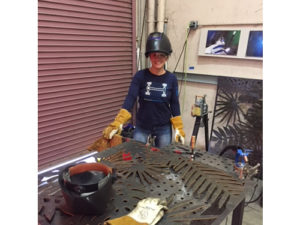Makerspaces—physical spaces that create communities for collaboration, skill building, and equipment sharing—are multiplying on campuses across the country. These spaces give students hands-on, collaborative, and entrepreneurial experiences that complement classroom instruction.
Carol Pepper-Kittredge, statewide director of the California Community College (CCC) Maker Initiative, describes makerspaces as “centers for innovation,” in which students learn and test new skills. “Faculty can explore new ways of teaching using new technology and incorporating inter-disciplinary experiences into their courses,” says Pepper-Kittredge. “In makerspaces, students can explore in a deeper way where their true passions and interests lie and uncover future career paths.”
Dale Dougherty, founder and chief executive officer of Maker Media and chair of the CCC Maker Advisory Committee, says that makerspaces flip traditional learning by putting practice before theory. “What excites me about learning in makerspaces is that this experiential hands-on learning gives us feedback that allows us to be good learners. It’s not so much about aptitude as it is effort and interest. I hope students realize that they can develop what they are capable of doing, and while it might be hard, they can do it,” he says.
A starter’s guide
To help more colleges develop their own makerspaces, the CCC Maker Initiative, which is housed at Sierra College in Rocklin, Calif., has published a free startup guide. The guide was created after tracking the first year of experience of 34 colleges in creating makerspaces on their campuses and describes the steps to establish makerspaces, including assessing needs of the particular college community, charting a campus’ specific environment, analyzing that data, and piloting faculty and student engagement.
The good news is that you don’t need a lot of money to get started. As Dougherty says, “I’ve seen successful low-budget makerspaces start small and grow as they develop interest among students and faculty.” Also, you may want to invite the broader community to join in: tap in to expertise, interest, and opportunities that exist beyond your campus, and get others involved.
The makerspace at Sonoma State University in California has education students combine journals, sketchbooks, and electronics to create prototyping tools in the introductory course called Hack Your Notebook. Students use the makerspace to practice making paper circuitry and make connections across the science, technology, engineering, art, and math disciplines. Education students are taught how to create projects and activities for their own students. Carinne Paddock’s experience using the makerspace is documented on Sonoma’s YouTube channel, where she explains what she learned and how she has infused maker curriculum into her lessons for her fourth-grade students. Paddock emphasizes making mistakes, learning from them, and moving on.
Education students benefit by the approach of the maker mindset for K-12 students, resulting in children who take more risks and learn perseverance as they make and remake. The Hack Your Notebook course is a part of Sonoma State’s Maker Certificate Program, where educators can learn to incorporate making into their teaching.
Community collaboration and real-world skills are vital to today’s innovative economy. If implemented well, makerspaces have the potential to offer long-term benefits for higher ed, producing students who will be better prepared to handle the interpersonal, collaborative, and practical challenges of today’s workforce.
- How we connect incoming students to the university resources they need - July 4, 2025
- AI and the workforce: Reskill to meet the moment - July 1, 2025
- Beyond the game: Why business expertise is the future of sports management - June 26, 2025
